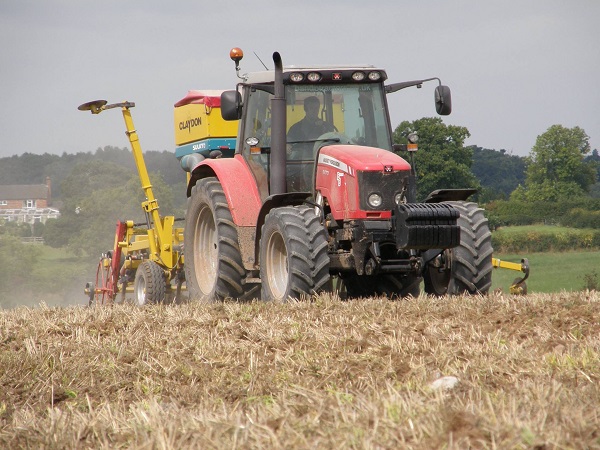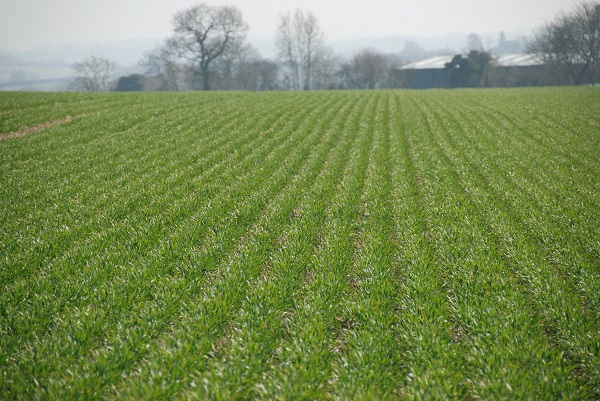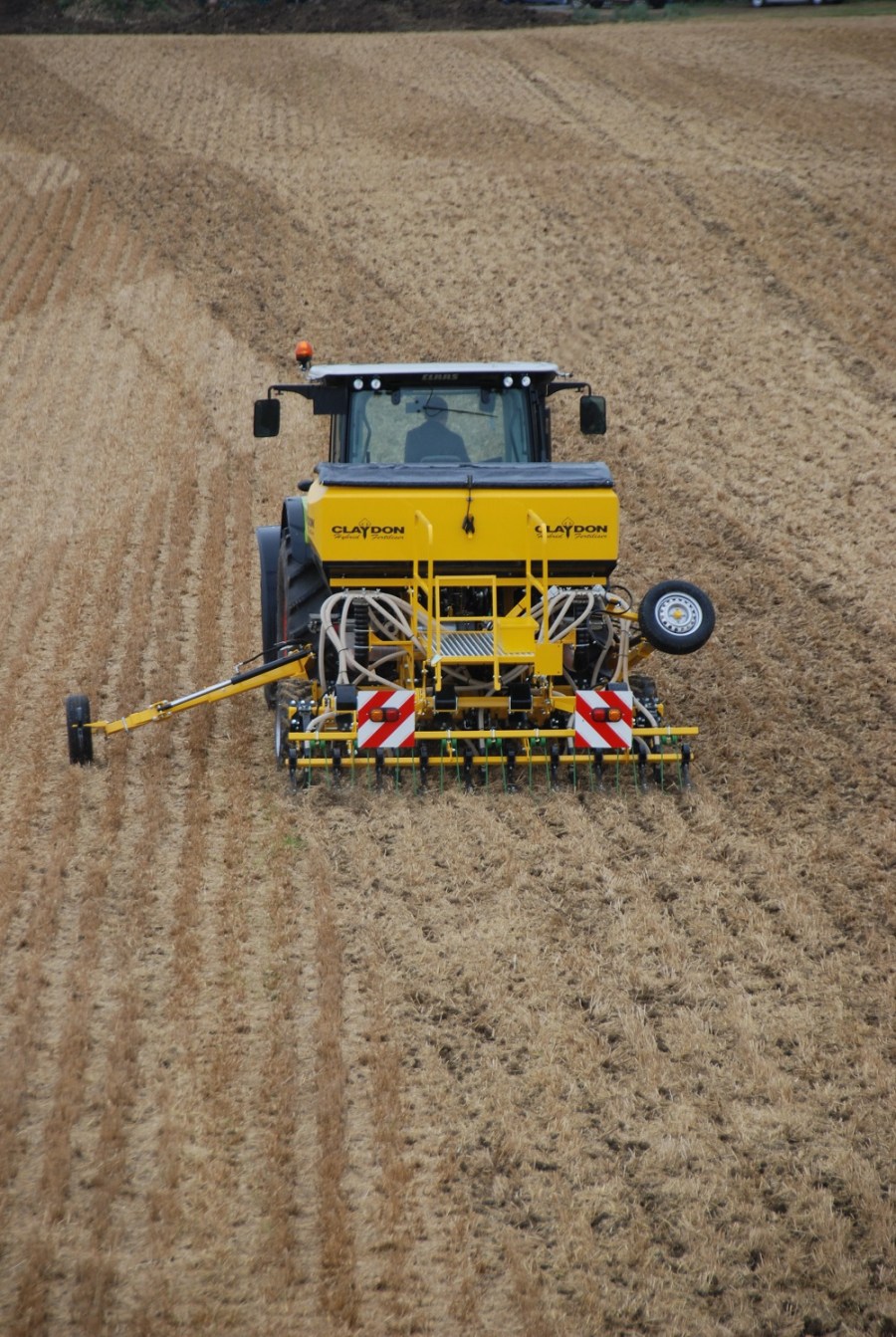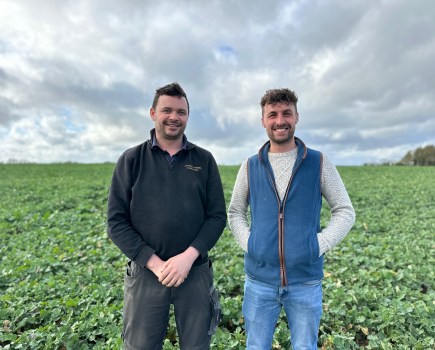The past few years have seen a complete change of policy at Park Style Farm in Derbyshire as the plough has given way to strip-tillage. CPM reports.
Over the years with the Claydon, the soil’s been getting easier and more open.
By Jane Brooks
It’s some years since the Holmes family ventured into strip-till territory, with their purchase of a Claydon SR drill, as Rob Holmes relates. “I work in a farming partnership with my father Keith and brother Pete. Until 2009 we’d always been a plough and combi-drill based enterprise – we ploughed everything.”
The Holmes farm 280ha of arable land, together with a further 80ha of grassland. They’ve recently been rearing replacements for a local dairy herd. But, as former dairy farmers themselves, there’ve been discussions about the pros and cons of getting back into dairying.

The Claydon is a different concept – a modular drill Rob Holmes adapts to most situations.
“On the arable side, we grow 135ha of wheat. It’s mostly feed wheat, which goes to an independent local farmer who stores it. There are about half a dozen other farmers who go to him and he always treats us well.
“We’ve grown milling varieties, but have limited storage. Dickens, JB Diego, Costello and Graham do well on our ground. We also grow a little Crusoe for milling. There are 30.5ha of spring beans, we’ve been growing Fanfare, but plan to try Vertigo this year.”
They also grow 50ha of winter barley, all Glacier, another 22ha of spring barley and 36ha of oilseed rape.
“Luckily we don’t really have a problem with blackgrass. We want a wide rotation and are quite late here, we struggle to get OSR in early enough and we wouldn’t be able to get cover crops.
“We were going to put in spring beans but they didn’t germinate well. So we thought we’d put spring barley in – probably RGT Planet.”
It was Keith Holmes who really pushed to give up the plough. “Back in the spring of 2009, we were walking the fields and saw all this lovely tilth on the top,” recalls Rob Holmes. “Dad pointed out we were going to plough all that in next year and start all over, so why can’t we just drill straight into it? So, well, that’s where the ball went and we brought the Claydon SR.

The Claydon Strip Tilling System works the soil in the immediate seeding zone but doesn’t disturb the areas in between.
“We probably should have min-tilled for a couple of years to get the soils ready, but we just jumped straight in. But over the years with the Claydon, the soil’s been getting easier and more open.”
The soil at Park Style Farm is all clay, mostly heavy. They’ve one field called ‘Brickyard’ – a handy reference to its former use. Rob Holmes does have one regret – in the wet winter of 2012 he ploughed 40ha. “It was the worst thing to do – with hindsight I should have left it and used the Claydon to put spring barley in.”
Also in 2012 Rob Holmes spotted a video Claydon had put online about their newly developed wet weather spring-tine kit. He thought it was an interesting idea but was disappointed it wasn’t suitable for use on the SR.
“We always try to get to Claydon’s annual open day, have a walk around, a chat and see what’s new. This was where we first saw the Hybrid drill. I also thought they had probably gone as far as they could with the SR. New development seemed to be going in the direction of the Hybrid and I wondered if it was time to consider changing the SR.
“We didn’t do anything then, but at the end of the season I saw the ex-demonstrator 3m Hybrid complete with fertiliser hopper offered for sale on their Facebook page. We decided to trade in the SR for the ex-demo. We also ordered the wet weather kit, to give a longer drilling season.
“With the SR, we found crops would germinate and come up well, then almost stall and yellow off a bit. But with the Hybrid, we put fertiliser with the seed – with nil ploughing, there’s poorer mineralization of nitrogen in the soil. But that application with the seed keeps it green and moving and also helps any residue breakdown.”
The ground is prepared by spraying the majority of stubble, he continues. “With OSR, as soon as the fields are cleared, the drill goes straight in. TSP fertiliser is applied to everything when drilling, and urea is used on the OSR at a rate of 50kg/ha.”
Slugs were a problem last year, he reports. “They were in the layer of soil under the trash and we wanted something just to break it up for two inches so the slugs had to surface, and hopefully bump into a slug pellet.
“As a stopgap, we got some very shallow trailed discs – going to just 50mm depth – which made a nice job but put ridges in. So we’ve brought a Cousins 3m surface cultivator, to mix in the trash after OSR and beans.”
Originally the Hybrid put the fertiliser behind the leading tine and then the A share put the seed behind that. But Claydon came out a couple of years ago, and two men spent two days modifying the drill. They fitted new stainless steel distributer heads, as well as moving the fertiliser coulters from the front legs to the rear tines. They also put on larger diameter fertiliser pipes and moved the electronics to a purpose-built box.
“So now the drill puts in the leading tine, then the A shares, then puts the seed down and fertiliser is applied behind the seed, while the following harrows just cover it up with soil.”
Rob Holmes advises that for drilling in Dec he uses two rows of the green harrows, rather than batterboards, for better coverage in wet conditions. He says they’re also good for drilling small seeds as they don’t cover them too much.
“We’ve added a micro-granule applicator to apply elemental sulphur. It used to go on with the first application in spring but now we put it in with the drill in autumn and it’s job done. Everything gets sulphur in the autumn, even the winter beans, but the winter barley and spring beans don’t get any fertiliser through the drill.
“Then in spring we’ll go with nitrogen, spinning it on with the Kuhn. While we apply P and K at a variable rate, we feel we get more benefit from blanket applications of nitrogen. I’ve recently completed my BASIS training so now we make our cropping and application decisions with our agronomist Robert Simister of M. G. Simisters and Sons, who are members of the CrestGroup.”
Patchwork GPS is used for guidance only and Soyl for field analysis. Rob Holmes did recently have a Yara N Sensor on trial, but he didn’t feel the benefits justified the cost. Variable rate seeding is on option he is currently considering, as germination can be patchy due to soil variations.
“The Claydon hybrid is a simple and well built drill, which is one of the beauties of it. Calibration is easy – using the Accord system you just weight a sample out put it in the box and that’s it, it’s calibrated. The RDS Artemis control screen sits in the tractor and is generally easy to use once you have the hang of it. Apart from the modification, which cost us nothing we haven’t had any problems at all with the drill.”
Providing the grunt up front is a Massey Ferguson 6480, notes Rob Holmes. “It’s on 650 tyres and carries a tonne of front weight, so we do have a bit of a compromise with the weight of the drill as we need traction. Claydon have bought out a trailing conversion kit and we’re wondering about upgrading, converting it from mounted to trailed. Then we can remove the tractor’s front weight and reduce tyre pressure.
“The Claydon is a different concept – it’s really a modular drill that we can adapt to most situations. We can put the twin tines on for wet going. If we want low disturbance drilling we can take the leading tines out and put discs in. If we do go down the trailing-kit route we can use leading discs or press wheels to work ploughed ground – we could have two drills in one basically, which is rather exciting.”
Wet weather tine kit
When weather or wet soil conditions dictate, Rob Holmes uses the Claydon Twin-Tine Wet Weather kit on the hybrid drill. This helps to prevent the seed going into the wet channel left by the leading tine.
The kit replaces the second seeding tine with two seeding tines, which create a fine tilth. The seed is placed in a 30mm wide band running 75mm to each side of the slot created by the leading tine.
The two seeding tines are suitable for a wide range of seed, including beans. They operate over the same range of working depths as the conventional seeding tine.
“In poor conditions the normal A shares wouldn’t make enough tilth,” notes Rob Holmes. “So without the wet-weather kit we’d have to either plough or go for spring cropping. We also use a double harrow bar with green spring tines with the kit, which we find gives good soil coverage. Most crops we drill with the wet-weather kit come on well, it’s only in waterlogged soil where they fail.”
Claydon claims that the narrow tine design of the twin-tine wet weather kit enables operation in wet, heavy soils without smearing or pulling up large clods of soil. What’s more, the company says there should be less slug damage as the seed slot is closed off.
What is strip tillage?
Having increased in popularity over recent years, strip tillage only disturbs the soil in the seed row, creating a seedbed where it’s needed as opposed to over the entire width of the drill.
While strip tillage is often seen as a form of direct drilling, it’s more accurately described as being between min-till and direct-drill. The level of ground disturbance is similar to a shallow min-till with a stale seedbed being formed.
The Claydon Strip Tilling System works the soil in the immediate seeding zone but doesn’t disturb the areas in between. The Hybrid drill used by Rob Holmes also places fertiliser into the seeding zone at drilling, which he says is exactly where the young plants need it.
In common with min-till, good management is the key to success, while the benefits can be increased sowing speeds and lower establishment costs.
Farm Facts
Park Style Farm, Rodsley, Derbyshire
- Area Farmed: 280ha arable
- Soil Type: Clay, mostly heavy
- Elevation: 91m
- Cropping: Winter wheat, winter barley, oilseed rape, spring beans, spring barley
- Mainline tractors: 2009 Massey Ferguson 6480, 2007 MF 6470, 2009 MF 5475
- Telehandler: 2x Kramer Telehandlers
- Combine: New Holland TX66, 6m header
- Sprayer: Trailed Kuhn Metris 3202, 24m
- Fertiliser spreader: Kuhn Axis 30.1 QE
- Drill: Mounted 3m Claydon Hybrid
- Cultivation: 7.5m Claydon straw rake, 3m Cousins Surface Cultivator
- Agronomist: Robert Simister, M. G. Simisters and Sons
- Staff: Rob and Pete Holmes, with their father Keith; occasional seasonal contracting work provided by Neil Sessions




